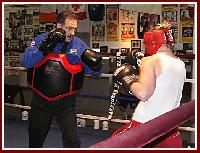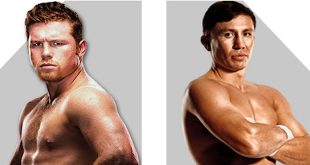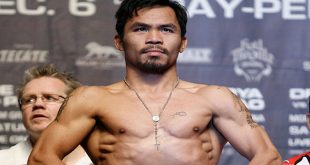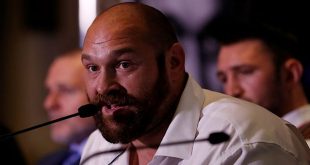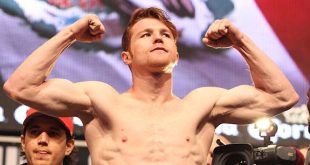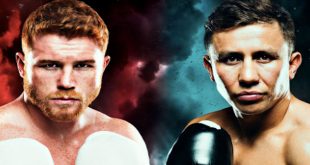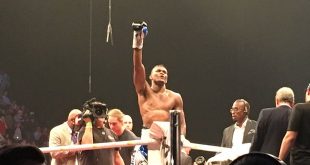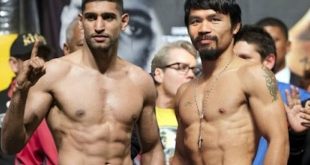“It could have been the hotdog guy and Walcott would have taken his advice.”
the 100-title mark at the Northeast Regional Golden Gloves, and the Portland native was named coach of the year for the third time in a decade. I sat down with coach Russo to talk about teaching the sweet science, growing up in the fight game and the infamous Ali-Liston II, which Russo attended at age 10..
Starting young
Russo got an early introduction to the sport, beginning at age 8 with weekly trips to fights at the Portland Expo with his uncle, the late George Russo, former Maine Boxing Commissioner and the man responsible for bringing Ali-Liston II to the state. In the 60s and early 70s, Portland was a thriving boxing town and the young Russo started training at the Arena Gym at age 12.
“I’ve always been in boxing, ever since I was a little kid,” Russo said. “My uncle always took me around. I trained a lot. I didn’t end up fighting because I was blind in one eye. But I had to exercise my love of boxing, so I was a gym rat. I was in the gym all the time, sparring and all that stuff.”
At 19, he headed to Vegas, driving cabs just often enough to keep a few bucks in his pocket, and spending his time soaking up all he could from hall of fame trainer Chuck Bodak.
“He worked with (Oscar) De La Hoya and all that,” Russo said. “He’s an old man; he was old then. Just a wealth of knowledge and a great basics coach, he was all about balance. Out there, you get to spar and work with and see world-class people. Sugar Ray Leonard in the gym; Duran’s in the gym; Foreman would come in. I saw all the guys of that era. I saw Tommy Hearns when he was still in the Olympics. The whole team came and trained at our gym.”
And he attended a lot of top bouts. “There were so many fights in Las Vegas, you could go to three to four a week that were world-class fights ? ESPN level at least. I saw Leonard fight Hagler there; I saw Hagler and Mugabi; I saw Spinx beat Holmes the second fight, which I actually thought Holmes won. It was a great education. “My experience in Vegas is invaluable to us now,” Russo said. “That’s why I think my fighters look good. Their balance is good. You gotta have basics. It’s a sport of basics.”
He said his experience at Johnny Garcia’s Main Street Gym in Vegas was a stark contrast to what he saw in the Maine gyms, where fighters basically trained themselves. His two yearlong stints in Vegas shaped Russo’s coaching style and would lead to great things down the road.
Ali-Liston II. May 25, 1965
After Muhammad Ali became a conscientious objector against the war in Vietnam, many states refused to sanction his bouts. After the original date for Ali-Liston II in Boston was cancelled due to an Ali hernia, Boston didn’t want the fight back. Maine State Boxing Commissioner George Russo set up a venue in a hockey rink in Lewiston for what would become one of the most infamous fights in Ali’s storied career.
“Lewiston and Maine will always be synonymous with unfortunately, somewhat of a black eye, but it least it was some kind of an eye,” Bobby Russo said, laughing. “I was 10,” Russo said. “I wanted to be there. My uncles, my cousins, (George) got us all tickets up front. Everybody was there. Willie Pep, Chuvalo, Floyd Patterson, Joe Louis, Jimmy Braddock was there, the Cinderella Man, it was unbelievable.”
The fight ended abruptly in the first round when Ali dropped Liston with a short, stiff right to the jaw that some dubbed “the phantom punch.” The crowd went nuts, and many still contend that the fight was fixed. Russo doesn’t buy into that belief. “A fight isn’t fixed unless the wrong guy wins,” he said, adding that in the first fight “Ali really showed that he would beat Liston 100 out of 100 times. (Liston) might have taken an easier route, but he was going to get beat anyway. The fight started and Ali hit him with enough of a shot to put him down on all fours, he kind of ran into the shot. I think it was enough to put him down. I don’t think it was enough to keep him down.
“The key issue was (referee Jersey Joe) Walcott. He was heavyweight champion, but he wasn’t that experienced as a ref,” Russo said. “Back in those days, they appointed celebrity-type guys and he mishandled it. Ali kept disrupting the count, and they were actually up fighting again” when the fight was stopped.
After Liston got to his feet and the fight resumed, the editor of “Ring Magazine” said, “This fight’s over. He’s been on the canvas for 18 seconds.”
“It’s none of his business,” Russo said. “He’s just writing the story, not making the story. But Walcott was looking for help, so he took it. It could have been the hotdog guy and Walcott would have taken his advice.”
The Greatest
“Ali got people of my era totally enthralled,” said Russo, who owns both sets of gloves from Ali-Liston II. “There was actually two different guys. Young Cassius Clay was an unbelievable talent and actually took the fight to you. He didn’t really run around much. He’d come at you throwing a lot of punches. But Ali, the older Ali, was different. He was resting a lot, using his smarts. He played more chess with them. “Ali, as far as technical skills, really didn?t do much right at all,” he said. “But he was just a phenomenon in his tremendous instincts catlike instincts. He had natural balance and radar. This kid out here (PBC flyweight Jorge Abiague) is the same way. You could literally take him and roll him down a hill at 100 mph and he’d end up in perfect position, just like a cat. Unbelievable.”
The beginning
A few years after Russo wrapped up his second stint in Vegas, he was living back in Maine when he ran across a friend whose nephew wanted to box. Russo agreed to train him, and then coached heavyweight Jessie DiBiase to a Golden Glove title. The sole loss in DiBiase’s career came at the hands of Lawrence Clay-Bey, who Russo would later work with in the Olympics.
The PBC is an old-school spartan training facility, tucked away at the end of an erratically paved, winding road that begins at the back of a restaurant parking lot. The two closest buildings are abandoned, burned out and covered with graffiti. If you didn?t know for certain that the club was down there, you?d likely turn back, assuming your directions were wrong. But at the end of that road lies a nondescript building with a sign reading “Portland Boxing Club.”
Inside, the club has a warehouse feel, with the wide open space disrupted only by a pair of small bathrooms, Russo’s office, a makeshift training area for visiting boxers, and of course, the ring. The walls are covered with photos and fight posters showing many of boxing’s biggest names. It’s not pretty. It’s not trying to be. But it’s unquestionably functional.
“This place is the Taj Mahal compared to what it was” when he took over, Russo said. It was a shell of a building with no doors, no windows, no electricity, no plumbing and trees growing up through the cracked floor. “That was about 15 years ago,” he said. “And we?ve been going ever since. It just gets better and better all the time.”
Russo said in the early days, keeping the club afloat required a financial juggling act, maxing out credit cards during stretches of training, then hoping to make enough money from the half dozen club fights each year to pay everything off. From the start, the PBC enjoyed tremendous fan support, and soon the club started working its way out of the red.
15 years later, not only is the non-profit club surviving, it’s thriving. Russo has put two of his fighters through college, and plans on helping a third starting next year. And the coach is in the planning stages of a large expansion that would make the PBC a facility capable of hosting national boxing events.
Russo said during the 60s and 70s, there were club fights in every small town, but with so much televised boxing now, those days are gone. “But I think it can still be done in a place like this, a city like (Portland),” he said. “The smaller the town, really the more effective it is, because the people rally around the locals. They do a show up in Claremont, N.H., with heavyweight Rich Gingras, an amateur show. They’ll get 1,200 people. And that’s because that’s all it holds. Portland is big enough, yet small enough to be able to do that.”
Jab in, jab out
“Everything starts with the jab and everything finishes with the jab,” Russo said of his coaching style. “It gets you straightened back out again and stops the guy from countering. You line him up, land a couple or three punches and then you come back, boom, and you’re ready again. You’re never not ready. Usually (opponents) feel the tempo and think you’re gonna stop. You go 1-2-3, and they go 4-5-6. You never give them that opportunity by freezing them with the jab.”
He said sometimes fighters have a tendency to try to finish combos with a big power shot and “that’s where you get in trouble, because you finish off-balance, then they counter back,” he said. “The jab is the best thing, or at least a left of some kind. The left will get you back.”
“My style is a pressure boxer,” the coach said. “Which was Chuck’s style. There wasn’t a lot of bullshit to it. Everyone kind of thinks they’re supposed to jump around and stuff when they first come in. I tell em to skate, so you know where your balance is all the time. Then pretty soon, you can almost do it blindfolded. Your feet tell you where to punch from. It’s almost like buttons on your feet. When you feel the weight, that?s where you punch from. You couldn?t do that running around. “Chuck was always about your feet and positioning and where you were balance-wise,” Russo said. “Don?t pull yourself off-balance and when you get somebody else off-balance that’s when you attack. If you practice good balance, there?s not a lot of opportunity to attack you, because you?re ready. They might be pushing you back, but if you go back and plant on that foot (smacking a fist into his hand), you let them run right into a right hand. He liked to use the other guy?s momentum, let him run into shots.”
New prospects
With a waiting list of over 100 would-be boxers hoping to train under Russo, the coach said newcomers generally work with some of the veterans until they’ve proven both talent and dedication. He said he’s reluctant to put people in the ring, “I almost discourage them,” he said. “There’s three months or so that you’re still learning where to put your foot. (The other boxers) get them to the next level, then I work with them before they ever spar. They obviously have to get used to the contact. They have to get hit a little, so I somewhat oblige them on that. I whack ?em around a bit and get them used to the jab and the body punches. I’m not trying to hurt nobody, but this is the harsh reality of it.
“Being a tough guy is almost a bad thing,” he said. “You have to be smart enough to have some fear and the athleticism to execute in the most stressful situation. Really there’s one out of 100 that becomes a fighter. I help everybody that comes in, but I have to focus on the guys that look like prospects.”
Match-ups
“You’ve gotta know what you’re doing in terms of match-ups, or you’ll get your guys hurt,” Russo said. “If you’re active and you see what’s out there, you know how to match it. When I match a guy with (18-0 pro welterweight Jason LeHoullier), the first question I ask is what kind of amateur background did he have, because that’s everything. Pro record means absolutely nothing. If he didn’t have much amateur experience, I wouldn’t even have to look into that any further. We’ll take that.”
Russo said it also helps to have a network of contacts like the one he’s established that includes hall of famer Russell Peltz. “He’s the main guy for ESPN, the matchmaker,” he said. “If I don’t know, I can call him and ask, Who is this guy and what does he fight like?? Or I’ll go to Russell and ask for an opponent that might work for Jason.
“Jason, being the kind of raw brawler that he always was, has got to be put in right. Like (Jose) Medina, who Jason beat on ESPN last summer. If we had let Jason fight him eight fights before that, he would have lost. Because that kid could box. And tough, too. Jason took his head off with a right hand and he jumped back up. I couldn?t believe it.
“We’re bringing (Jason) up right,” he said. “And I tell you, the guy who beat Zab Judah, the undisputed welterweight champion of the world, Jason would beat that guy. He’s the world welterweight champ and he’s no better than Jason.”
Russo said he would be leaving on March 3 for Colorado Springs, where women’s World Amateur Welterweight Champion Lisa Kuronya will try to add the national title and No. 1 ranking to her list of accomplishments. Then he’s back getting LeHoullier prepped for a March 25 bout.
“Then we have a couple of club-type shows, and we go to Oregon again (for the Portland-versus-Portland event),” Russo said. “That’s another reason we’re successful here. We go after it.
We get experience, we travel all over. There’s no place that I don’t wanna be if there’s fights and match-ups that make sense for my guys.”
 Boxing News Boxing News
Boxing News Boxing News
